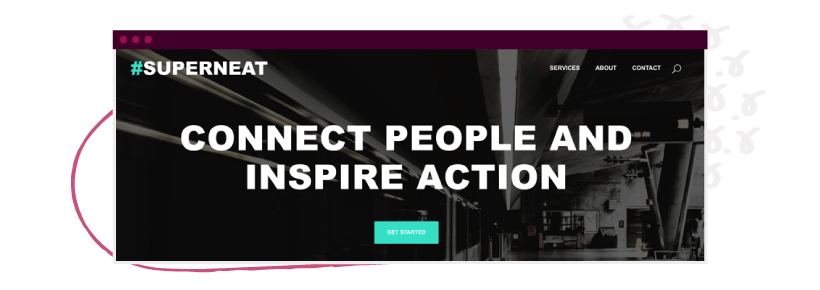What is a brand positioning statement? A positioning statement expresses the essence of a brand with precision. This persuasive one-line statement is internal-facing, designed to guide the business forward in a purposeful way. A brand positioning statement is the beating heart of the brand, capturing the reason the business exists and the legacy the brand aspires to be remembered for.
The options are truly endless for brands today, aren’t they? Seems like we have more channels than we know what to do with, a massive bouquet of messaging tactics we lug around every day as we woo our audience.
Marketers are creating content left and right to reach people. However, the results from Bynder’s State of Branding Report show that marketers are worried about breaking through the noise. When polled on their biggest concern regarding their 2021 marketing efforts, the No. 1 issue (26 percent) was how they’d be able to reach their target audience on increasingly crowded digital channels.
This is why there’s no better time than now to revitalize your brand positioning statement. This persuasive statement is one of the few content secret weapons that will help you cut through the thick noise to personalize experiences and get your brand voice heard.
What is a brand positioning statement?
A positioning statement expresses the essence of a brand with precision. This persuasive one-line statement is internal-facing, designed to guide the business forward in a purposeful way. A brand positioning statement is the beating heart of the brand, capturing the reason the business exists and the legacy the brand aspires to be remembered for.
Mahan Khalsa had this to say in his book, ‘Let’s Get Real or Let’s Not Play’:
“The irony is, the harder you try to ‘sell’ people, the less likely it is going to happen, and the more likely it is that the trust alarm will go off. Once the trust alarm goes off, information flow is curtailed, and you are less likely to get a solution they perceive meets their needs.”
People expect a lot out of brands today. Those people will become customers — and eventually, brand advocates — if they know that your business is truly vested in their success versus being some company that wants to hit revenue goals.
A brand positioning statement is an opportunity to align your internal team around your purpose, ensuring brand consistency across all of your communication efforts.
What a brand positioning statement is not
Marketers mix up brand positioning statements quite often. Uncertainty is understandable since you’re managing and maintaining messaging foundations that express today and tomorrow, who you are and where you’re going, why you’re relevant, unique… sigh.
To clear up the confusion, let’s compare and contrast positioning statements with seemingly similar brand statements.
1. Brand positioning statement vs. value proposition
Value propositions and positioning statements are used interchangeably, almost as commonly as mission and vision statements. A value prop focuses on the benefits a customer will experience from a functional and emotional perspective.
The positioning statement is then created from this value proposition, bringing in the deeper “why” of your brand and how you serve better than any of your competitors.
2. Brand positioning statement vs. tagline
Positioning statements and taglines are snappy and memorable, yet a tagline is an external declaration, and a positioning statement is an internal expression. A tagline takes center stage on a home page or social media ad, and it changes over time.
The positioning statement is behind the scenes, an unwavering message that informs every tagline iteration. As it is foundational, a brand positioning statement does not change frequently like a tagline.
3. Brand positioning statement vs. elevator pitch
Your elevator pitch is the spiel you rattle off to someone you meet at a networking event. You know the way this plays out. A stranger with a drink in their hand squints at your sticker name tag and asks you: “So, what does your company do?”
Your positioning statement is not a spiel where you quickly explain what you do. It’s bigger than that… It’s your brand’s essence. A positioning statement is the reason why your brand is here rather than an explanation of your brand.
4. Brand positioning statement vs. mission statement
Your mission statement defines what you do today. The mission is the core of the business, but it is about the internal perception of the brand. A mission statement shapes a company’s culture, and it is often used in hiring materials as well as on the about page of a website.
A positioning statement is about the external perception of the brand. What does your customer get out of working with you? How is your brand meeting your customer’s needs?
5. Brand positioning statement vs. vision statement
Your vision statement defines where you are going tomorrow. The vision is the future of the business — and like the mission, this statement is about the internal perception of the brand. A vision statement helps teams move toward achieving a common goal together because they know their purpose.
A positioning statement brings in some of this “why” but, again, it is more about your customer’s viewpoint. This message is less aspirational and more competitive. Why should your customer remember your brand above the rest?
How to write a brand positioning statement that’s persuasive
Now that you know what a brand positioning statement is — and what it is not — you’re ready to hash out your own.
Your brand positioning statement should answer these four questions:
- Why is your brand here?
- Who is your brand here for?
- What need does your brand fulfill better than anyone else?
- What do you want your brand to be remembered for?
… in one sentence.
So, the colossal challenge with positioning statements is that you aren’t creating a brand manifesto. You must package everything up in a neat one-liner. Fortunately, you already have other brand messaging and content strategy foundations you can reference to help you answer these questions. Any other mysteries can be solved with additional research.
- Why is your brand here? Reference your mission statement and values.
- Who is your brand here for? Reference your personas, product reviews, testimonials, customer success stories, and customer interviews.
- What need does your brand fulfill better than anyone else? Reference your value proposition, tagline, competitor research, case studies, and go-to-market strategy.
- What do you want your brand to be remembered for? Reference your vision statement and content vision.
Yes, that is a lot of content to corral and conquer, but you need to audit your brand in its entirety to truly understand your brand positioning.
When all else fails, having a good positioning statement template will guide your messaging strategy. There are many templates out there, but this clever formula from Brandwatch is fantastic:
(Brand) is a (1) company that provides (2) with (3) by (4).
- The category in which the brand operates
- The target audience
- The benefit to the customer
- The reason why the brand will deliver on this promise
Here’s a brand positioning statement example:
Superneat Marketing is a content marketing agency that provides growth stage companies with an avenue to increase trust, conversions, and loyalty through inspiring and educational experiences.
- The category in which the brand operates: Content marketing agency
- The target audience: Growth stage companies
- The benefit to the customer: Increase trust, conversions, loyalty
- The reason why the brand will deliver on this promise: Inspiring and educational experiences (the heart and soul of Superneat… and their competitive differentiator)
Brand positioning statement examples to spark ideas:
Positioning statements examples from our favorite brands are difficult to come by since these are internal-facing statements. Like Grandma’s secret sauce, nobody’s offering up their brand positioning statements on a silver platter.
Let’s use the brand positioning statement formula from Brandwatch again to understand what positioning might look like for a few brands. We’ve included their mission and vision statements as well to help you visualize the messaging differences.
1. Patagonia:
Patagonia is an outdoor clothing and gear company that provides adventure enthusiasts top-tier solutions for enjoying wild and beautiful places through environmentally responsible products.
Mission: We’re in business to save our home planet.
Vision: A love of wild and beautiful places demands participation in the fight to save them, and to help reverse the steep decline in the overall environmental health of our planet.
Learn more about Patagonia’s mission.
2. Southwest Airlines:
Southwest Airlines is a customer-focused airline company that offers a fun, comfortable way for travelers to fly with friends in the sky.
Mission: The mission of Southwest Airlines is dedication to the highest quality of customer service delivered with a sense of warmth, friendliness, individual pride, and company spirit.
Vision: To become the world’s most loved, most flown, and most profitable airline.
3. Kaiser Permanente:
Kaiser Permanente is a health insurance company that provides members and communities with high-quality, affordable care so anyone can be healthy and thrive.
Mission: Kaiser Permanente exists to provide high-quality, affordable health care services and to improve the health of our members and the communities we serve.
Vision: We are trusted partners in total health, collaborating with people to help them thrive and creating communities that are among the healthiest in the nation.
Learn more about Kaiser Permanente’s mission.
Now listen to the beating heart of your brand
There is no shortage of challenges you will face as a marketer when you are on a mission to reach people. The voice your brand projects out into the world must be relatable to your audience while being more powerful than any of your competitors.
Having a strong brand positioning statement will anchor you and your team. This internal expression is both necessary and inspiring for informing all of your communication efforts — be that marketing, sales, or customer success campaigns and programs.
If you need help with yours, check out our managed content creation services to see how we can help you craft a positioning statement that captures the essence of your brand.










